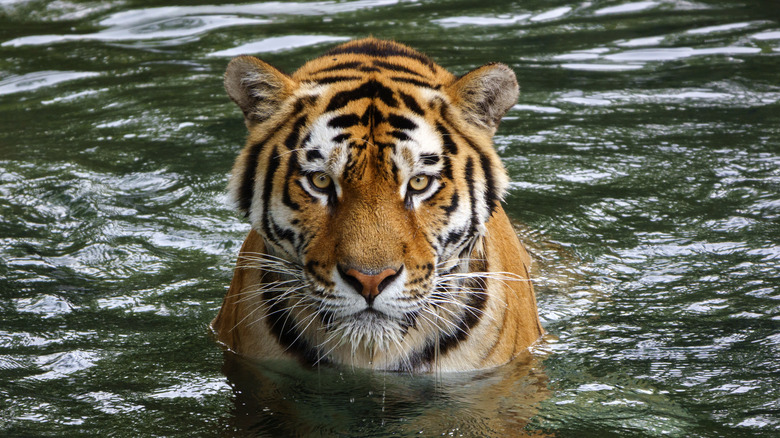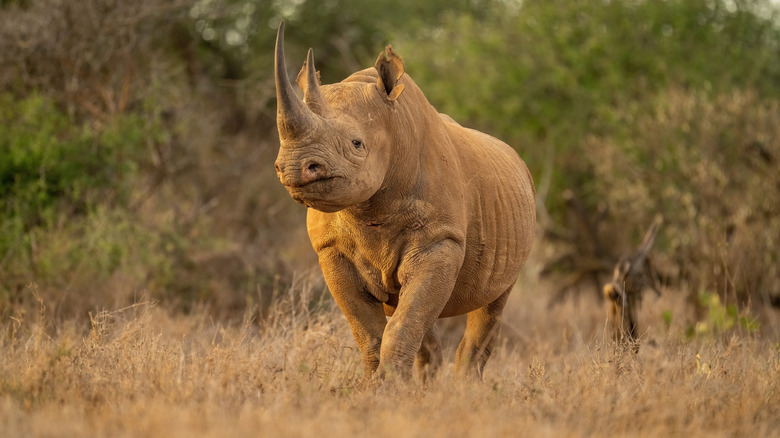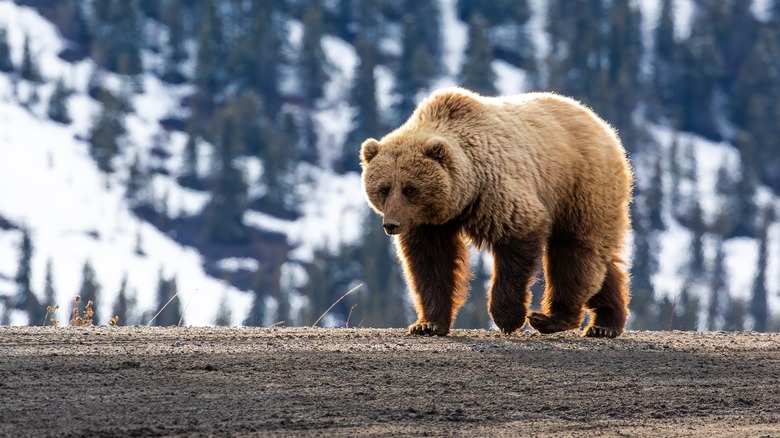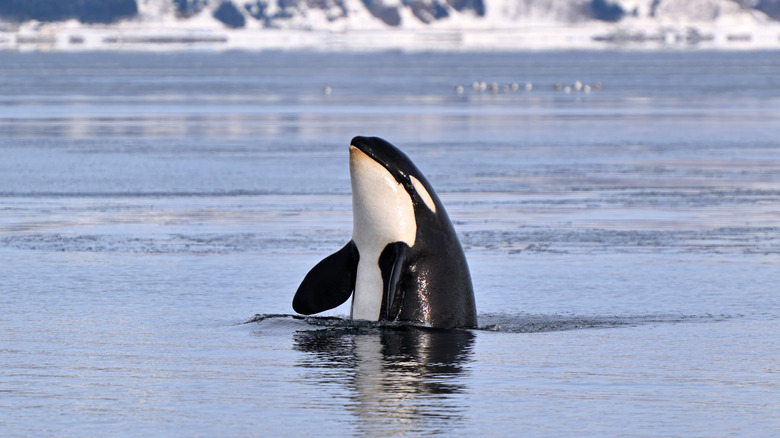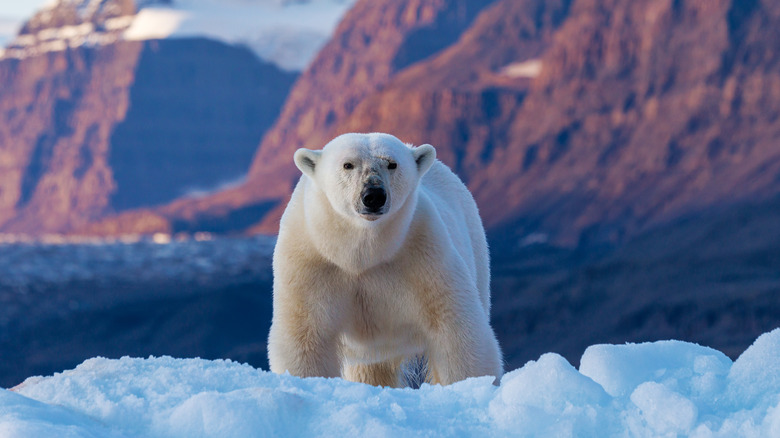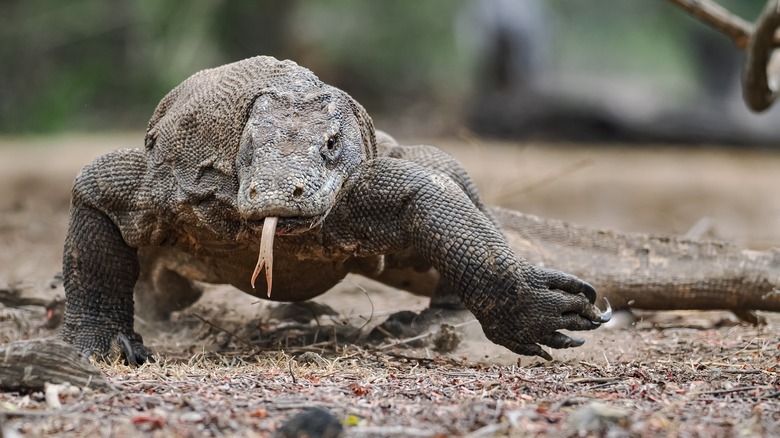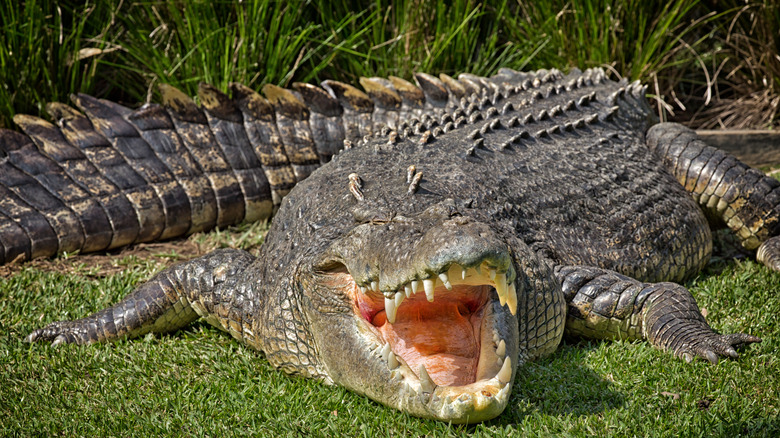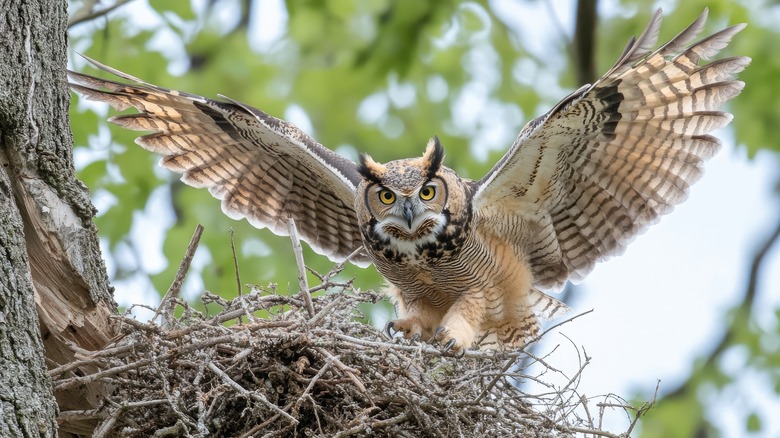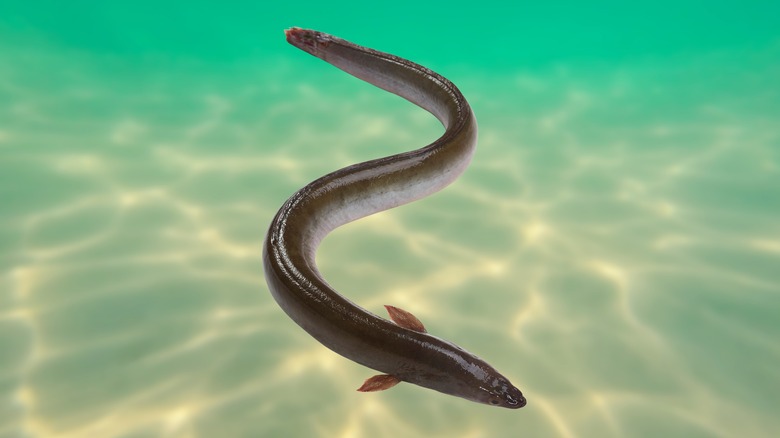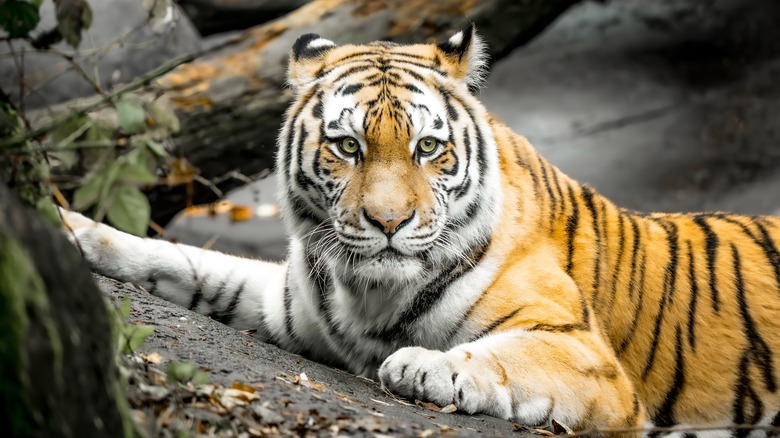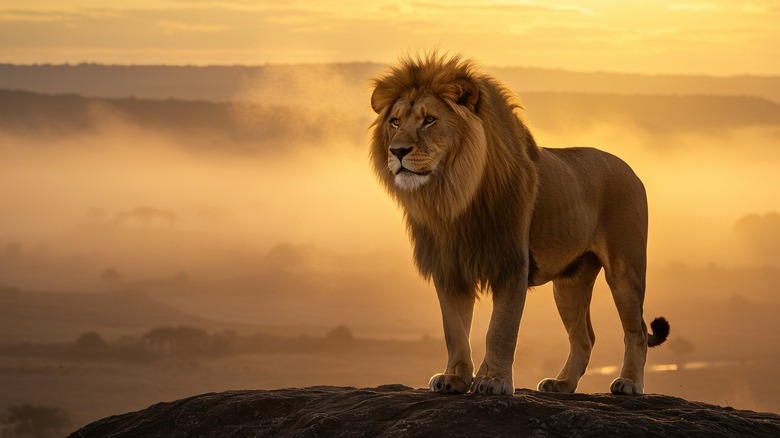These Tough Animal Species Have No Natural Predators
Nature can be a dangerous place, even for animals that seem borderline invincible. For instance, hippos may be massive mountains of muscle with a gaping maw, but that doesn't stop a sufficiently motivated pride of lions from viewing them as a mobile steak buffet. Still, every proverbial mountain has a top, and perching atop it are a handful of animals that have no natural predators whatsoever. Interestingly enough, such animals are surprisingly varied in nature. Predators, omnivores, and herbivores all have their representatives in this exclusive club, though understandably, apex predators hog the biggest number of spots. (It's easy to have no natural enemies when you're at the top of your local food chain.)
Still, it should be noted that no animal on this list is completely safe from outside influence. Thanks to the myriad ways we influence nature, humanity is either a potential or immediate threat to animals in even Earth's most biodiverse ecosystems. What's more, animals aren't born fully formed and fighting fit, which means that several species we're about to discuss have multiple predators when they're still young. Apart from these caveats, though, the following animals are among the precious few that can live their lives without worrying about other species trying to feed on them.
Rhinos are too tough to be hunted
There are five different types of rhinoceroses, and none of them are pushovers. At their absolute largest, the biggest white rhinos can be 6 feet tall and weigh up to 7,920 pounds. A rhino's armor-like skin can be 2 inches thick. Despite its tank-like build, the rhino is also deceptively fast, and some can run up to 34 miles per hour.
And then there's the matter of the signature horn (or two horns, depending on the species), which the rhino can and will weaponize when needs must. This combination of solid defense, dangerous offense, and surprising turn of speed means that even the hungriest predators are all too happy to cross the proverbial street when a group of these mighty herbivores draws near. Yes, there's a chance of encountering a group; on top of everything else, some rhino species like to roll out in teams.
All that being said, the life of a rhinoceros is also a stellar example of nature's unpredictability. Though adult rhinos don't need to have to worry about predators, young calves face danger from just about every sufficiently large predator in the area, including wild dogs. As is so often the case on this list, humans are also a considerable danger. Rhino horns are made of keratin, and they're historically an in-demand commodity in several countries' medicine and culture. Because of this, the animals are constantly in danger of being targeted by poachers.
Grizzly bears are too fast and powerful to have predators
As its Latin name Ursus arctos horribilis suggests, the grizzly bear is no joke. The biggest grizzlies can reach the height of 8 feet while standing on two legs, and they can weigh as much as 900 pounds. This makes the largest brown bear subspecies a formidable land mammal that can vanquish just about any threat with its sheer size and massive claws. Much like the rhino, the grizzly bear is also far faster than its size would suggest: Should you encounter one, sprinting away will not help you, as the bear can run 35 miles per hour. (For comparison, the fastest human in the world can briefly touch the speed of 27.33 miles per hour.)
A dedicated omnivore, the grizzly is just as likely to forage roots and berries as it is to catch fish and hunt small prey. Still, it's more than fearsome enough to be utterly safe from all other animals, which more than qualifies it for inclusion in this list. However, the bear does have one major natural enemy: Human hunters and poachers, who have done a number on grizzly bear populations over the years. These days, 48 U.S. states protect the grizzly as a threatened species.
Orcas are the top predators of the seas
Various horror movies and thrillers have taught us that the sea is full of things to be wary of. But real life backs this up just as well; you need only see some of the strangest deep sea creatures ever discovered — or perhaps risk taking a peek at some prehistoric sea animals that are pure nightmare fuel. Even so, there's one sea creature that can swim around with very few worries in the world, at least when it comes to predators. No, it's not the great white shark. It's the thing that hunts great white sharks and eat their livers.
The animal in question is none other than the orca, colloquially (and fittingly) known as the killer whale. These black-and-white apex predators of the ocean can be 32 feet long and weigh around 6 tons, which gives them a distinct size advantage against most sea animals. What's more, they tend to live in groups called pods that can have as many as 40 members, and they're intelligent enough to communicate and use group tactics when they hunt. This strength in numbers means that even baby orcas are fairly well-protected from other predators.
Humans, of course, remain a threat. Historically, we have both hunted orcas and captured them for aquariums. Nevertheless, it seems that even Homo sapiens doesn't really shake orcas all that much. In fact, they have occasionally interacted with people — sometimes attempting to share their catch with researchers, sometimes attacking and sinking boats off the coast of Portugal.
Polar bears surpass even humans in their local food chain
It's one thing for an animal to be the apex predator of its habitat, but completely another when it's still true after you include humans in the equation. This is the case with the polar bear, which is considered to be above Homo sapiens in the Arctic food chain. It's no surprise, considering that polar bears are not only very aggressive, but also absolutely massive: The largest polar bears can be close to 10 feet tall standing up and weigh up to 1,700 pounds.
With a layer of fat that can exceed 4 inches and two layers of fur, the polar bear is uniquely suited to survive the cold environment, and its massive paws with curved claws are both effective running tools and dangerous weapons. Combine that with a dangerously powerful bite and a keen sense of smell that enables polar bears to locate faraway prey, and it's easy to see why no other Arctic animal preys on these majestic and fearsome beasts.
Fortunately, humans are rarely the polar bear's first choice of nutrition. Less fortunately, their habitat (and therefore diet) is rapidly changing. Ideally, a polar bear prefers to hunt seals on sea ice, but climate change means that their icy hunting grounds are rapidly melting, forcing the animals to either adapt or perish. This has increasingly caused them to roam the land ... which, in turn, has increased the number of dangerous encounters between humans and bears.
Komodo dragons are unchallenged by other species
The Indonesian, island-dwelling Komodo dragon is a peculiar but impressive creature, as far as apex predators go. The largest living lizard species today, Komodo dragons can grow as long as 10.3 feet and weigh up to 366 pounds. They're avid meat eaters that are just fine with carrion, but they also like to patiently wait for passing prey in order to sneak in a nasty bite.
Should this occur, the prey is effectively dead, which has little to do with bite force or tooth size. A Komodo dragon's saliva is a terrifying cocktail of venom that stops blood from clotting, as well as plain old bacteria. The bite will eventually incapacitate or kill the prey, after which the Komodo dragon (and often a few of its buddies) can track down the prey animal at its leisure.
Don't take the fact that Komodo dragons like to lunch together to mean that they're one big, happy family, though. In fact, apart from loss of habitat due to rising sea levels, a Komodo dragon's only real threat is a bigger Komodo dragon. The species is known for cannibalism, and sufficiently large specimens are fully willing to munch on weaker members of their own species.
Bald eagles rule the skies
Fittingly, the national bird of the United States is a pretty tough cookie — far more so than its physical characteristics would suggest. While its up to 8-foot wingspan and sharp talons are no joke, a bald eagle weighs no less than 14 pounds, which makes it one of the absolute lightweights on this list. Then again, since it happens to be a bird of prey that can fly up to 100 miles per hour, it's pretty pointless to compare its bulk to land-dwelling apex predators.
The animal kingdom at large poses basically no threat to the adult bald eagle. It, on the other hand, poses a significant threat to fish, crustaceans, small mammals, and other birds. It's also fine with feasting on carrion, and has been known to stalk smaller birds of prey and steal their catch.
Unfortunately, the bald eagle needs to reach adulthood to be safe from other animals. Younger, nest-bound specimens are food to just about any opportunistic bird or mammal that can sink its claws, beaks, or teeth in. As is so often the case, humans are also a considerable risk factor — and historically, bald eagles suffer from humanity's actions more than many other animals. People used to hunt them ruthlessly, and the widespread use of the pesticide known as DDT greatly affected their numbers before it was banned. Fortunately, we have learned from our mistakes and conservation efforts have managed to bring the species back from the brink of extinction.
The saltwater crocodile is a threat to everything around it
Jaguars have been known to hunt caimans, but good luck to any big cat predator that tries to tackle a saltwater crocodile. The largest of all crocodiles, they can even grow to be 23 feet long and weigh 2,200 pounds. Native to Oceania and South Asia, this top predator is notorious for having a literally crushing bite force of 3,700 psi, making it one of the animals with the strongest bite ... if not the absolute strongest one.
Few animals would even dream of messing with a highly aggressive 23-foot crocodile with jaws of steel, which is more than enough to put the saltwater crocodile in the "no natural predators" category. This is doubly so because the saltwater crocodile itself is such an avid hunter: It spends much of its time lying still by the water or even fully submerged, only to launch a surprisingly fast and incredibly violent attack on whatever prey ventures close enough — be it a fish, a buffalo, or even a human.
Great horned owls terrorize the night
The great horned owl is proof that if you happen to be the toughest thing with wings in your living area, you tend to be pretty safe from natural predators. In some ways, the great horned owl is an even more impressive example of this than the bald eagle, considering how much smaller it is. While the eagle can have a wingspan of 8 feet and weigh some 14 pounds, the great horned owl manages to terrorize its environment with a 5-foot wingspan and a weigh of just around 5 pounds.
Great horned owls might not be the biggest guys around, but their sheer adaptability and ruthlessness more than make up for that fact. They thrive in regions that range from various forests to prairie regions, descending on a wide variety of targets — from rabbits and ducks to more challenging targets like skunks or even other birds of prey.
The great horned owl's versatility and hunting skills mean that the adult birds tend to stay off the menu, except if they're targeted by another great horned owl. Their powerful talons and night-time activity make them effective hunters, and only one prey animal has developed a decent defense against them. Crows, which are very much part of the great horned owl's diet, have been known to defend themselves against the larger bird by dive-bombing the owl in groups. Crows, along with raccoons, may also target baby owls and eggs while they're still in the nest.
Electric eels have a shocking way to keep natural predators at bay
The second fully aquatic animal on this list is the electic eel, which admittedly doesn't seem like the kind of animal that would deter every single predator in its northern South American habitat. However, that's only because it's difficult to comprehend precisely how electric this up to 8-foot fish is.
The electric eel isn't particularly fast, and its eyesight is awful. However, what it does have is a set of three special organs that enable it to emit electricity for various purposes. Some shocks are for communication, and others are intense series of electrical bursts meant to catch nearby prey. However, when the fish gets truly serious, it can send out a shock of 600 volts at a 1-amp current. That's more than enough to kill pretty big animals, up to and very much including human beings.
Because of the electric eel's ability to administer shocks that range from tiny tingles to full-on fatalities, they have zero natural predators ... at least, ones that come at them more than once. Since they live in an environment that may leave them stranded on comparatively tiny and shallow pools during dry season, there's always a chance that a land-based predator decides to experiment with electric eel hunting. This is invariably a bad idea, because apart from being able to shock the water around it, an electric eel can simply jump out of the water to shock the wannabe predator directly.
The Siberian tiger reigns supreme among big cats
The mighty Siberian tiger is likely one of the first animals with no natural predators that spring to mind. After all, the largest of these feline predators can be over 12 feet long and weigh 933 pounds, and they can reach speeds up to 60 miles per hour. Combine that bulk and pace with amazing camouflage, great strength, massive claws, and powerful teeth, and the Siberian tiger can walk the land unopposed by other animals.
The diet of the Siberian tiger consists of ... well, pretty much whatever it wants to eat, provided that it's meat. Wild boars and deer are common prey, but if the opportunity rises, the animal will think nothing of attacking other animals — including Asiatic black bears. In all fairness, these smallish bears aren't exactly grizzlies, as they only weigh up to 440 pounds. Still, it's telling of the Siberian tiger's might that it considers any bear a prey animal.
Once more, humanity is the biggest threat here. Siberian tigers usually go out of their way to avoid humans, but have been known to attack and devour people on rare occasions (though the few tigers that give human flesh a try do tend to develop a taste for it). Humans, in turn, have been even less kind to the big cat, which has been heavily hunted over the years. Its forest habitat in Eastern Asia is also getting smaller and smaller due to human activity. As a result, the animal is endangered, and only around 600 Siberian tigers exist in the wild.
Lions have no equal in their natural habitat
Lions aren't the most powerful animals on this list by any stretch of imagination. From orcas to grizzly bears, several animals on this list could most likely make short work of a lion in the right environment. In zoos, tigers have even proven to be mightier than lions in at least two unfortunate occasions where lions and tigers have found themselves in the same enclosure.
However, the lion's main trick has never been one-on-one brawling. They're distinct pack animals that live and hunt in groups called prides, using terrain for cover as they advance on prey and relying on their coordinated tactics to take it down. Prides can have as many as 30 lions in them, and since a single lion can be up to 8.3 feet long and weigh up to 570 pounds, no other animal in their native African grasslands is completely safe from a determined hunt — not even crocodiles or elephants.
As with Siberian tigers, lions do have their issues with humanity. Humans have taken over 90% of the African lion's original habitat over the years, which — along with poaching — is a major threat. Humans and lions have a long history of conflict that tends to peak when lions attack livestock during the dry season — a result of less available prey for the lions, which then leads to retaliation by humans.
